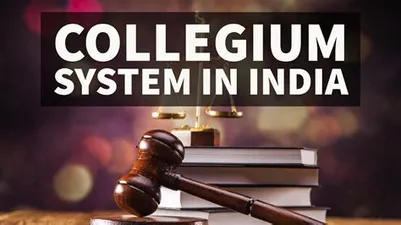The collegium system, which is currently adopted by the Indian judiciary, refers to a system where the Chief Justice of India and the four senior-most judges of the Supreme Court recommend candidates for judicial appointments to the President of India. The President is obliged to accept the recommendations and has no discretion in the matter. The system ensures that the judiciary has complete control over the appointment of judges to the higher judiciary, and it is based on the principle that the judiciary should be independent of the executive.
While the collegium system was created to ensure transparency and impartiality in the selection of judges. This system has been a subject of debate and discussion for several years in India, with many calling for reform and others defending it as necessary to maintain the independence of the judiciary.
Revisiting the evolution of the Collegium System:
The collegium system has its roots in the first judges’ case in 1982, where the Supreme Court held that the executive should consult the Chief Justice of India in the appointment of judges to the higher judiciary. In the second judges’ case in 1993, the Supreme Court held that the opinion of the Chief Justice of India would have primacy in the appointment and transfer of judges to the higher judiciary.
However, in 1998, the Supreme Court issued a controversial ruling in the third judges’ case, which further solidified the collegium system. The court held that the Chief Justice of India and a group of senior judges of the Supreme Court would have complete control over the appointment and transfer of judges to the higher judiciary. This decision effectively stripped the executive of its role in the appointment and transfer process and gave the judiciary complete control over the process.
Since then, there have been calls for reform of the collegium system due to concerns about a lack of transparency, accountability, and the concentration of power in the hands of a few judges. In response to these concerns, the National Judicial Appointments Commission (NJAC) was created in 2014, to establish a more transparent and accountable system for the appointment of judges. However, in 2015, the Supreme Court struck down the NJAC, with a 4:1 majority, and declared it “unconstitutional” and violative of the “basic structure of the constitution, effectively restoring the collegium system.
Thus, the collegium system evolved through a series of judicial pronouncements by the Supreme Court. While there have been calls for reform, the collegium system remains the dominant method of appointment and transfer of judges in India.
The Debate: Collegium vs Centre
The Collegium system has been the subject of much debate and controversy since its establishment. Critics argue that the system lacks transparency and accountability and that it gives the judiciary excessive power over the executive in matters of judicial appointments. Another area of debate is the lack of diversity in the judiciary. The Collegium System has been criticized for not promoting diversity in the judiciary, resulting in an under-representation of certain sections of society.
Proponents of the Collegium system argue that it is necessary to ensure the independence of the judiciary from the executive. They argue that if the executive were given a greater role in judicial appointments, it would lead to political interference in the judiciary and compromise the independence of the judiciary.Despite its controversies, the Collegium system continues to be the method used for judicial appointments in India.
The Constitutional Implications of the Collegium System Debate
The Collegium system has significant constitutional implications, particularly in terms of the separation of powers between the judiciary and the executive. The Constitution of India provides for the separation of powers between the three branches of government – the legislature, the executive, and the judiciary. Each branch is given specific powers and responsibilities, and no branch is allowed to encroach upon the powers of the other.
The Constitution also provides for the appointment of judges to the higher judiciary by the President, on the advice of the Council of Ministers. However, the Supreme Court has held that the appointment of judges is an essential function of the judiciary and that the executive cannot be given complete control over it.
The Supreme Court has also held that the Collegium system is a necessary component of judicial independence and that it is necessary to ensure that the judiciary has complete control over the appointment of judges to the higher judiciary.
However, some constitutional experts have argued that the Collegium system may conflict with the basic structure of the Constitution, particularly the principle of separation of powers. They argue that the system gives the judiciary excessive power over the executive in a matter that is traditionally within the purview of the executive.
Possible Alternatives to the Collegium System Several alternative systems could be considered to address the limitations of the collegium system. One such system is the National Judicial Appointments Commission (NJAC), which was proposed as a replacement for the collegium system in India in 2014. The NJAC proposed to have a six-member body, consisting of the Chief Justice of India, two senior judges of the Supreme Court, the Union Law Minister, and two eminent persons, who would be appointed by a committee comprising the Chief Justice of India, the Prime Minister of India, and the Leader of the Opposition in the Lok Sabha. The NJAC was intended to balance the independence of the judiciary with the need for accountability and transparency in the appointment of judges.However, the NJAC was struck down by the Supreme Court of India in 2015, and the collegium system was reinstated as the sole method for appointing judges. Since then, there have been ongoing debates and discussions about the need for reform in the appointment and transfer of judges.
Another alternative system that could be considered is the Independent Judicial Appointments Commission (IJAC), which was proposed by the Law Commission of India in 2018. The IJAC proposes a five-member commission, comprising a retired judge of the Supreme Court, two eminent persons appointed by the President of India, the Chief Justice of India, and a senior judge of the Supreme Court. The IJAC would be responsible for shortlisting candidates for judicial appointments, and the final selection would be made by the Chief Justice of India in consultation with the IJAC.
An alternate option for the collegium system could be the establishment of an independent judicial appointments commission. This commission could be composed of experts in law, academics, and representatives from the legal profession, as well as individuals from diverse backgrounds. The commission could be tasked with the responsibility of selecting and appointing judges to higher courts, based on a transparent and merit-based selection process.The selection process could involve a rigorous evaluation of the candidate’s qualifications, experience, and expertise in the relevant areas of law. The commission could also consider feedback and recommendations from various stakeholders, including the bar, judiciary, and civil society organizations.An independent judicial appointments commission could help promote greater transparency and accountability in the appointment of judges, as well as ensure that the selection process is based on merit rather than political considerations. Additionally, it could also help diversify the judiciary by encouraging applications from underrepresented groups and ensuring that the selection process is fair and inclusive.
Ultimately, any new system will need to strike a balance between preserving the independence of the judiciary and ensuring transparency and accountability in the appointment process.
Conclusion:
In conclusion, The Collegium System is a critical feature of India’s judiciary, ensuring some degree of independence and autonomy to the judiciary, it is also criticized for its lack of transparency and accountability. Alternatives to the Collegium System have been proposed, but they too have their own flaws and limitations.
The debate over the Collegium System and its alternatives raises important constitutional implications for India’s democracy and the rule of law. The principle of separation of powers requires that the executive, legislature, and judiciary operate independently of each other. Finding a balance between judicial independence and accountability is crucial in ensuring that the judiciary is fair and transparent.
As India continues to grapple with this issue, it is clear that there is no easy solution to the challenges posed by the Collegium System.
However, there is a need to re-examine the current system and explore alternative mechanisms that can address the flaws and limitations of the Collegium System while upholding the principles of independence and accountability.
























